Data visualization allows people to see the big picture at a glance, datapine’s website emphasizes. It lets them track key performance indicators methodically, making improvements as they look at what works and what doesn’t. From onboarding employees to tracking customer preferences, data tracking is key to success for CEOs, managers, sales personnel, human resources staff, and all those who make decisions that determine an organization’s success.
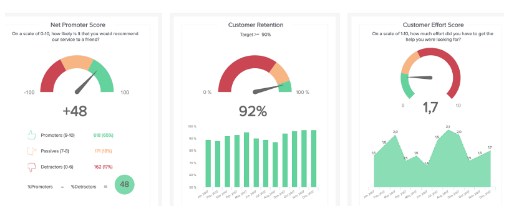
Example of a service and support dashboard offered by datapine.
However, data can prove tough to track for anyone who’s not an analyst. Data must often be drawn from multiple platforms, meaning that to make sense of it, one needs to combine and analyze it together. That’s where datapine comes in. datapine helps customers to make sense of all the data they’ve accumulated, and to visualize it. Customers who need to share data with their own customers or other stakeholders can present it in an easily understandable way. And to draw in those who stand to benefit greatly from their services, datapine turned to Content Pros.
datapine: Who They Are, What They Do
datapine provides dashboards and user-friendly dashboard-building software, which can be embedded in a customer’s website or application or used solely for internal reporting.
In doing so, datapine makes the complicated task of data analysis and reporting quite simple, giving their customers tools that clearly highlight successes and pinpoint areas for improvement.
We give them access to their data. They are able to analyze data from many different sources within one single place, and then they can track their performance over time within interactive real-time dashboards. This helps them to make better data-driven decisions, says Heiko, Head of Marketing at datapine.

A sales performance dashboard offered by datapine.
The software can also help customers monitor their results in real time, helping with decision-making. A startup founded about five years ago, datapine currently has 25 employees. The company provides one main product business intelligence software which can be modified with different features, depending on the customer’s needs. Customers span a broad spectrum of industries, from manufacturing, energy, and retail to media and publishing. They range from startups with ten employees to longstanding organizations with 1,000+ employees.
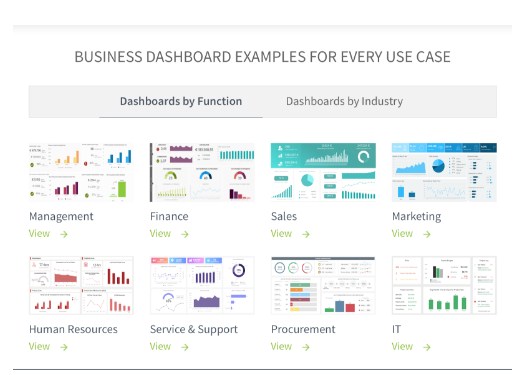
A sampling of dashboard types created by datapine.
Because the people who reach out to datapine typically aren’t data scientists, datapine’s blog content often helps them understand what the company’s products can do for them. The company knew that quality, frequently updated content would help the people who need their products find them and better grasp what they can offer.
How the Relationship with Content Pros Began
Before working with Content Pros, datapine was creating all of its blog content internally. The time it took a staff member to write blog posts created a huge bottleneck, says Heiko. Then the staff member who handled blog content creation left, and the company had an urgent need to fill the void. It felt like the right time to try a new tactic. Content Pros sent them an email at just the right moment, says Heiko. A blogging service sounded like just what they needed, and they were impressed by the value of what Content Pros was offering. They decided to give it a try and were struck by how easy the process was. Now, they only produce their own blog content when they need to write something very specific about their company, or when they need to make a simple update to existing content. The rest of the time, they trust Content Pros with their blog content creation.
Results and Time Frame
datapine started working with Content Pros in June 2016. The results they achieved far surpassed their expectations, going dramatically above and beyond what a staff member had been able to accomplish. After about three months, the company started seeing significant results, and blog traffic has been steadily increasing since then.
For the past three years, datapine saw their organic traffic to their blog double each year and is now seeing 100,000+ visitors per month. Plus, a full 90% of their blog posts get long-term traffic.
The quality of the blog content was quite good, datapine noticed right away. They knew that by working with Content Pros, they’d be adding a wealth of information to their blog that would continue to draw numerous potential customers over time. And he was right–from February 2016 to January 2018, blog traffic increased from an average of 6 to an average of 47 organic sessions per hour.
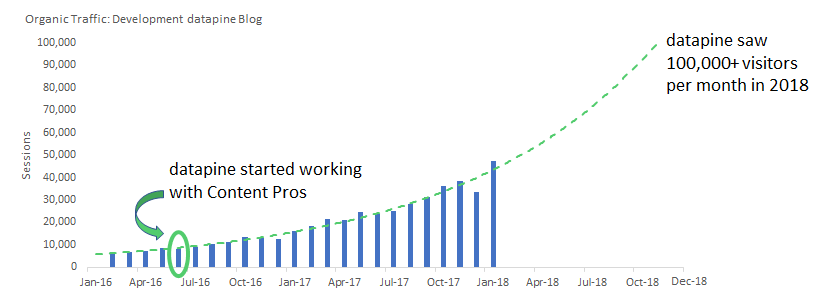
Data provided by datapine
You get everything all in one, he also notes, referring to thorough research with well-documented citations, quality content, a dedicated writer and editor, and additional services like the promotional content package that datapine subscribes to. There’s not much else for the customer to do besides post the article, he says.
How does Content Pros help a company achieve these results? Writing quality content is time-consuming, especially for someone who’s not an experienced content writer. A team of professional content writers and editors like Content Pros can create it far more efficiently than companies usually can on their own. Plus, multiple experts are reviewing the piece. It’s not just created by a writer and then slapped up on the blog a skilled editor reviews it before the customer ever lays eyes on it. A customer success manager stays in communication with those team members and the customer to ensure that the work is going smoothly and the customer is satisfied. All this results in the ability to create a more polished, well-researched, and highly targeted piece, and to produce it much more efficiently than customers typically could on their own.
What the Workflow Process Looks Like

The process of working with Content Pros is quite easy, says Sandra Durcevic, Content Manager at datapine. datapine researches keyword topics and then tells Content Pros it wants a post focused on specific keywords. There’s really not much more to the process on the customer’s side, Heiko chimes in.
Idea generation is on our side, says Sandra. We submit the topic idea that we have validated internally with the specific keywords that we would like to see implemented. She adds, It’s really a very general outline, and from that, the writers are able to research and write an article on their own. Then, all she has to do is review the completed piece.
Content Pros generates topic ideas for many of its customers, but with datapine’s skill at data analysis, they prefer to supply their own. They’re pretty strict about the topics they want their blog content to cover, says Heiko. We have the data on what ranks well and what doesn’t, he explains.
The work is very efficient, Sandra adds. Communication is very smooth, she also notes, referencing the ease of communication with Content Pros’ writers, editors, and other staff.
The Content Pros platform streamlines the conversation between all those involved in the process, making it easy for everyone to stay on the same page.
It’s easy to get in touch with Content Pros, says Sandra, and the staff stays in close communication with her and Heiko. When they have feedback about a piece, the team addresses it quickly. Any necessary revisions are done immediately, she emphasizes. Content Pros’s user-friendly platform works much better than email, notes Sandra. While an email thread can be hard to follow and makes it difficult to visualize what stage the project is at, Content Pros’s platform lets anyone know at a glance who is working on content creation, review, or revisions.
datapine’s Roadmap to Success
Strategy
Many organizations seek to generate quick bursts of traffic on their website by writing about trending topics in their blog, notes Heiko. However, generating one-time traffic doesn’t turn a blog into a resource for a particular community, he stresses.
“Our strategy is looking more long-term,” he emphasizes. “Our purpose was never to create blog content that gets one-time high traffic.” With every post, they aim to build on what they’ve already created rather than sharing a series of trending posts that become irrelevant in a couple of weeks. “We always focus more on long-term rankings,” he says. “It usually takes two to four months for the blog post to get the organic traffic we’ve planned for.”
That’s why their blog has become a resource that potential and current customers find consistently reliable, as demonstrated by the perpetually rising number of organic hits. This shows that they aren’t just posting on trendy topics but that the information is evergreen; valuable in the long-term.
Techniques
The blog is at the beginning of the conversion funnel, says Heiko. The blog is often a potential customer’s first exposure to what the company can offer. That’s where the customer starts thinking about what datapine can do for them. Thus, datapine aims to make the blog relevant to as many people as possible who could benefit from their services. Posts must be relevant to people across a wide spectrum of industries, since datapine’s target customer base is so large. A post about business trends will be relevant to a broad base, for example.
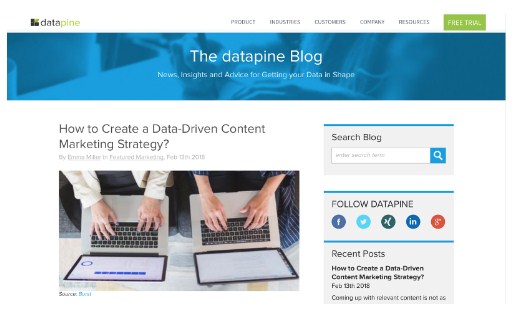
People who have already subscribed to their newsletter receive new posts by email, keeping them connected with datapine. This includes potential customers who visited the site in the past to purchase their products. It also helps datapine maintain a relationship with current customers while allowing those customers to share relevant information with business associates who may also be interested in datapine’s services. They get more customers than they’d expected from the email subscription, says Heiko. In the emails, they share bonus content related to their latest blog post as well as information about booking a demo or free trial. They receive 300 to 400 email leads from a blog post sent via email, and following up with those interested individuals often results in new customers.
datapine typically shares their content (in full or in part) through the following sources:
- The blog
- The newsletter
- Quora
Facebook has proven very useful for certain types of targeting, Heiko also notes. On Facebook, they’ll post more commercial content offering a free trial or the chance to book a demo, for instance to encourage customers who have already been exposed to datapine via the blog to take the next step.
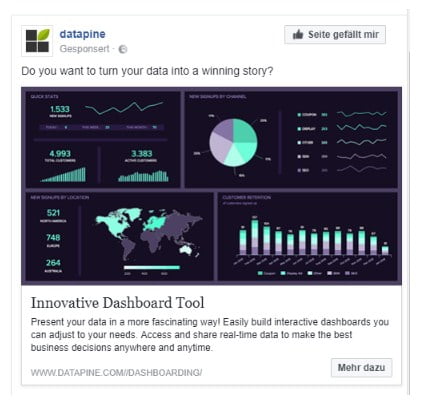 Facebook post by datapine.
Facebook post by datapine.
One caveat he voices about Facebook: “People are getting sick of FB advertisements. Two years ago, it worked way better than now, but two years ago, there were way fewer FB advertisements than now.”
Thus, they share their posts on a mix of social networks. In addition to Facebook and their newsletter, they use Twitter, Quora, LinkedIn and, more recently, Pinterest to share their blog content. Using promotional content that Content Pros has created, they’ll post answers to Quora questions that draw people who are interested in a certain topic to their blog post about it. datapine also found that LinkedIn groups perform quite well. They publish each post in 20 to 30 relevant LinkedIn groups.
By the time a potential customer is exposed to datapine a second time, often through one of these networks, “you know they are already interested in topics related to us, and then you just try to push them one step further,” says Heiko. Each exposure to datapine’s blog content makes potential customers more likely to take the leap to becoming actual customers. Using different platforms to which people are exposed increases the likelihood that their first encounter with datapine won’t be the last. The blog content, which covers more general topics, draws them in. Then, a visit to the Facebook page gets them thinking more specifically about what datapine can offer them.
Post Spotlight
To highlight the type of blog content Content Pros creates for datapine; a post from June 2019 titled “28 Sales Reports Examples You Can Use For Daily, Weekly or Monthly Reports” shares how to use sales reports to monitor and improve your team’s progress. With an engaging yet authoritative tone, the post advises readers on how to use metrics to assess and respond to each team member’s strengths and weaknesses. The post shares examples of what these reports look like, helping readers conceptualize how they can work with this data.
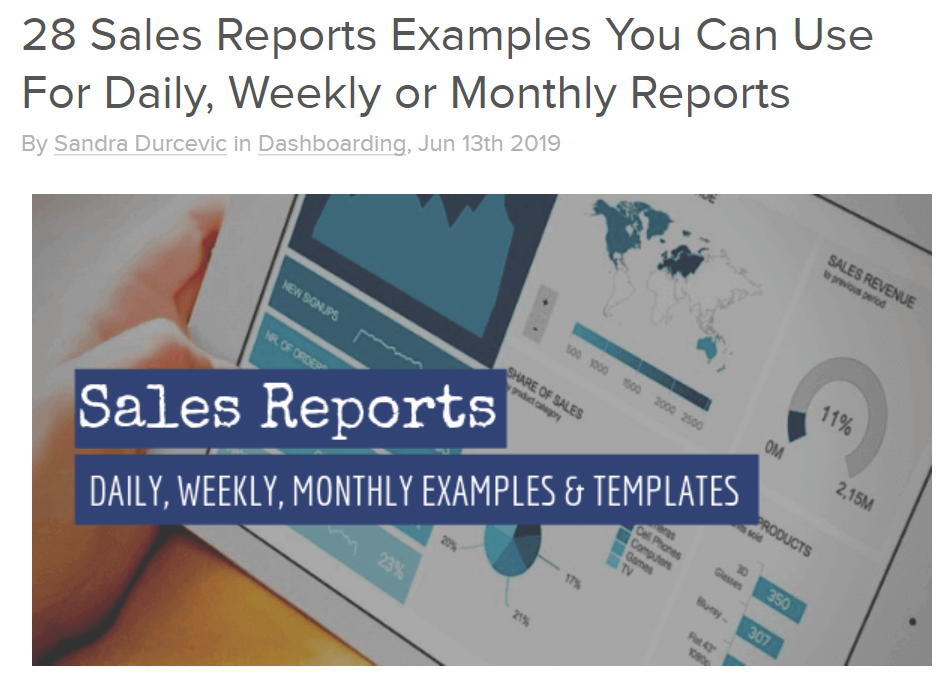 Blog post by datapine.
Blog post by datapine.
This post, originally written in 2017 and updated in 2019, still brings a lot of traffic, they note. It’s captivating, presents visuals to illustrate its points, and gives the reader the sense of being taken by the hand and guided through a complex concept step-by-step.
“It’s well written, it uses a lot of visualizations dashboards from our own tool and it’s bringing a lot of traffic,” says Heiko.
Other recent titles have included explanations of concepts like embedded business intelligence, key SaaS trends, and using metrics in recruitment to improve hiring choices. Again, most of their blog posts appeal to a broad base that doesn’t have a strong background in analytics, with an occasional post dipping into the ins and outs of a more technical concept that readers may have encountered or focusing on a specific industry. For example, one recent post looks at how to use business intelligence in the healthcare industry to improve patient experiences. Content Pros’s diverse group of writers allows datapine to delve into these topics within a variety of industries seamlessly.
Visualizations are always beneficial, Heiko and Sandra emphasize. They’re great for any kind of blog post, but particularly for illustrating what datapine does. Content Pros works with datapine to incorporate samples of their dashboards into their blog posts.
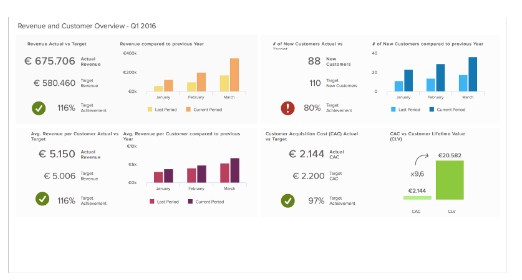
A revenue-tracking dashboard that datapine offers.
Heiko and Sandra assert that overall, Content Pros has been a dependable, long-term partner for their content marketing strategy.
“It’s not just about gaining new long-term customers.” says Tyler, Co-Founder of Content Pros. “It’s about building relationships and flexing to meet the diverse needs of our customers. We want each customer to get the most out of every piece we create for them. When we see our posts getting traction and giving someone exposure, we know we’ve done our job well.”



